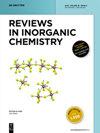Newfangled progressions in the charge transport layers impacting the stability and efficiency of perovskite solar cells
IF 3.1
3区 化学
Q1 CHEMISTRY, INORGANIC & NUCLEAR
引用次数: 7
Abstract
Abstract Organic-inorganic lead halide perovskite solar cells have rapidly emerged as a newfangled material for solar energy harnessing. Perovskite solar cells have succeeded in gaining a power conversion efficiency of 25% in the last year, further enhancement in the efficiency is anticipated due to advanced engineering of the different components making up the complete cell architecture with enhanced performance, stability and efficiency. Significant components of perovskite solar cell configurational architecture are the electron transport layer, active perovskite absorber layer, hole transport layer and counter electrode. Considering the profound role of transport layers in charge mobility, current review has particularly elucidated the advancements in the charge transport layers. The time duration of the review is from 2010 to 2021. However, the special focus has been laid on the recent articles. The influence of different organic and inorganic materials used for development of transport layers influencing the cell performance have been summarized. Materials used for transport layers have been modified by utilization of myriad of engineered substances through doping and surface functionalization strategies but every method have been marked by posing serious challenges towards the stability and efficiency of the cell and thus, hindering its commercialization. The review also provides an elucidation of the mechanical challenges and abatement strategies. These strategies are associated with the charge transport layers for enhancement of cell functionality.影响钙钛矿太阳能电池稳定性和效率的电荷传输层的新进展
有机-无机卤化铅钙钛矿太阳能电池已迅速成为太阳能利用的一种新型材料。钙钛矿太阳能电池在去年成功地获得了25%的能量转换效率,由于组成完整电池结构的不同组件的先进工程技术,具有更高的性能、稳定性和效率,预计效率将进一步提高。钙钛矿太阳能电池构型结构的重要组成部分是电子传输层、活性钙钛矿吸收层、空穴传输层和对电极。考虑到输运层在电荷迁移中的重要作用,本文重点阐述了电荷输运层的研究进展。审查的时间期限为2010年至2021年。然而,本文特别关注的是最近的文章。综述了不同的有机和无机材料对电池性能的影响。用于传输层的材料已经通过掺杂和表面功能化策略使用了无数的工程物质进行了改性,但每种方法都对电池的稳定性和效率提出了严峻的挑战,从而阻碍了其商业化。综述还提供了机械挑战和缓解策略的阐明。这些策略与电荷传输层相关联,以增强细胞功能。
本文章由计算机程序翻译,如有差异,请以英文原文为准。
求助全文
约1分钟内获得全文
求助全文
来源期刊

Reviews in Inorganic Chemistry
化学-分析化学
CiteScore
7.30
自引率
4.90%
发文量
20
审稿时长
1 months
期刊介绍:
Reviews in Inorganic Chemistry (REVIC) is a quarterly, peer-reviewed journal that focuses on developments in inorganic chemistry. Technical reviews offer detailed synthesis protocols, reviews of methodology and descriptions of apparatus. Topics are treated from a synthetic, theoretical, or analytical perspective. The editors and the publisher are committed to high quality standards and rapid handling of the review and publication process. The journal publishes all aspects of solid-state, molecular and surface chemistry. Topics may be treated from a synthetic, theoretical, or analytical perspective. The editors and the publisher are commited to high quality standards and rapid handling of the review and publication process.
Topics:
-Main group chemistry-
Transition metal chemistry-
Coordination chemistry-
Organometallic chemistry-
Catalysis-
Bioinorganic chemistry-
Supramolecular chemistry-
Ionic liquids
 求助内容:
求助内容: 应助结果提醒方式:
应助结果提醒方式:


